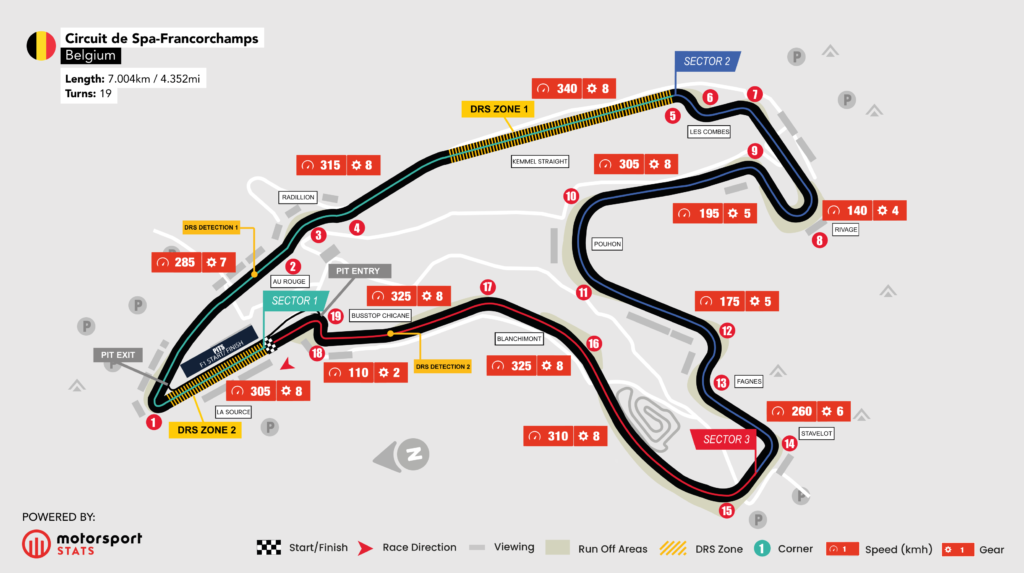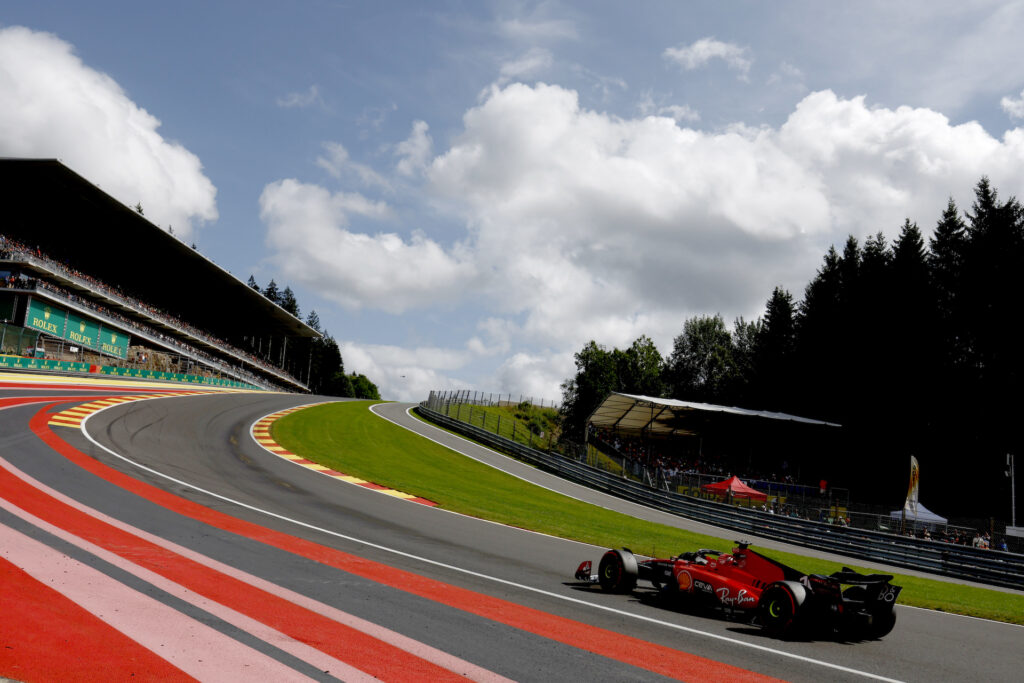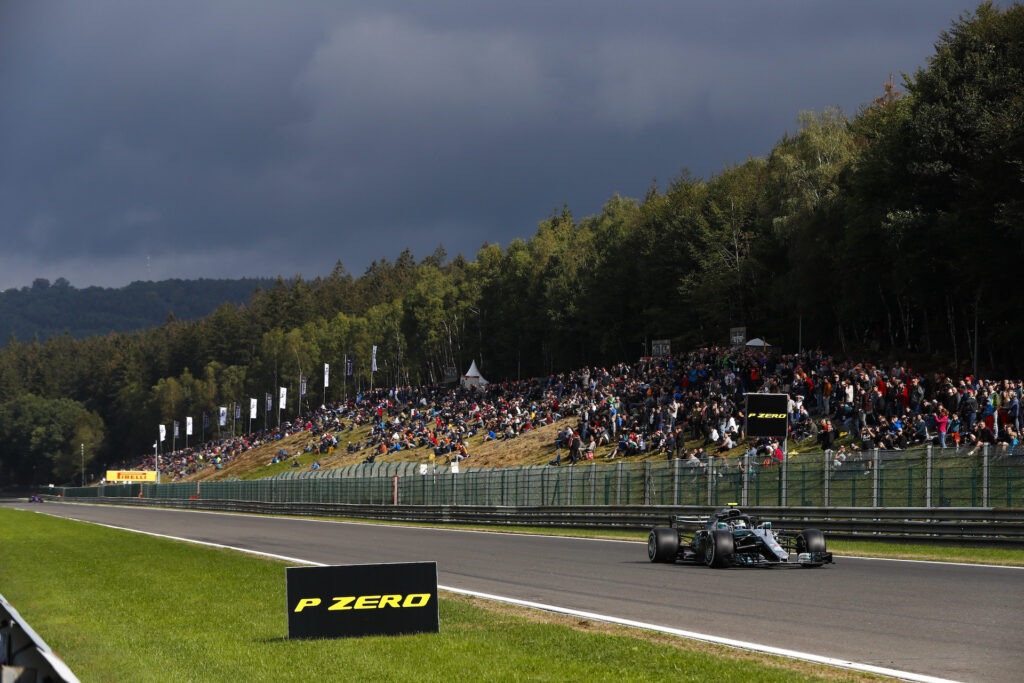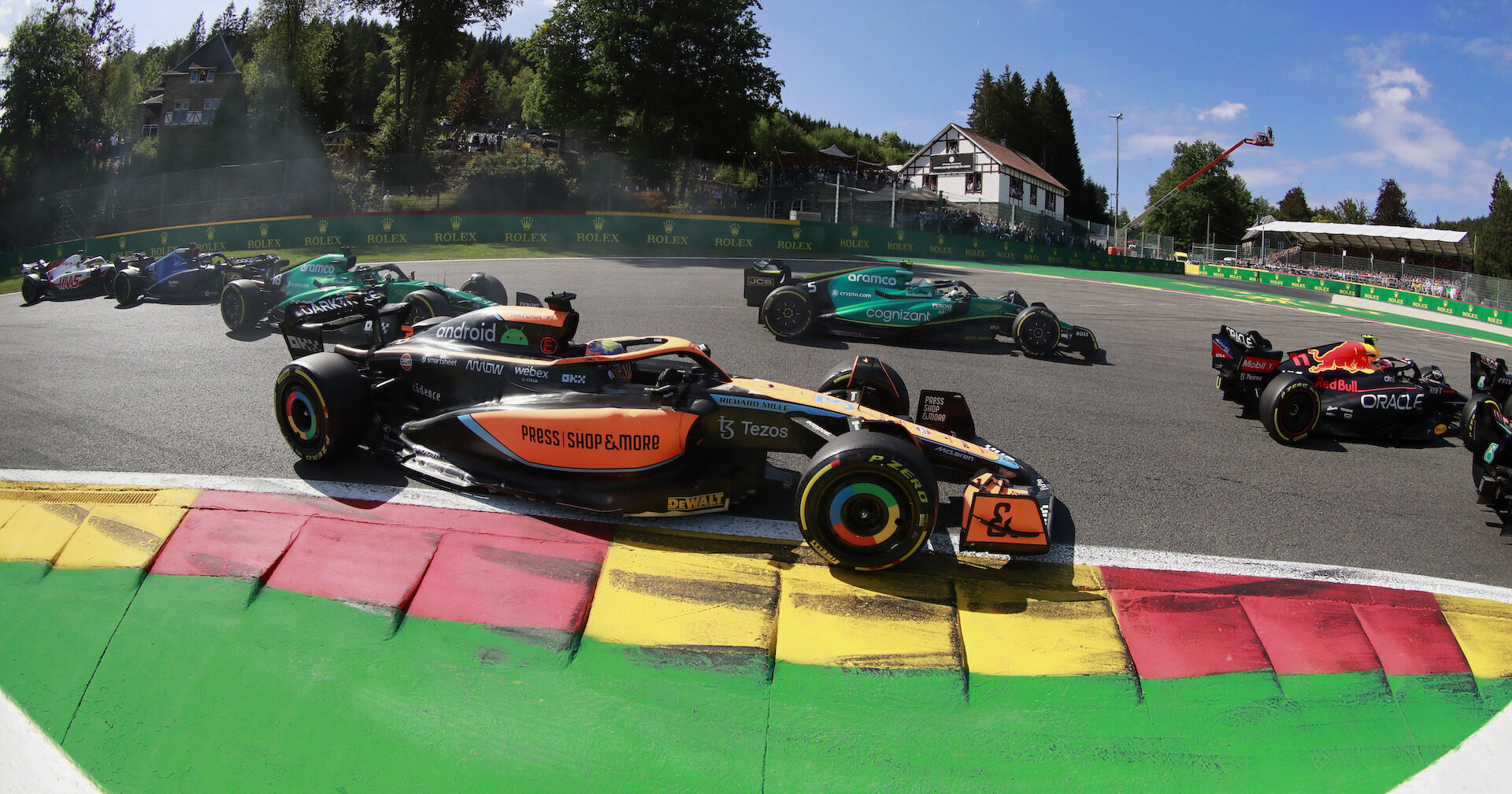For thrills, spills and heart-stopping moments that live long in the memory, the Belgian Grand Prix is a firm favourite of drivers and F1 fans alike. Boasting spectacular scenery and a highly unpredictable climate, the Spa-Francorchamps track was also once considered the most dangerous racing circuit in Europe.
While safety measures have improved substantially over the years, it is still considered one of the most challenging circuits on the planet, which is one of the many reasons thousands of F1 fans flock to Belgium’s Ardennes Forest each year to enjoy a weekend of high drama on the track.
In this guide, we’ll take a closer look at the Spa-Francorchamps circuit, learning how the turns got their names and discovering who currently holds the record for the fastest lap time!
Planning to attend the Belgian Grand Prix in 2025? Book your tickets now.
Spa-Francorchamps track layout

Spa-Francorchamps track stats
• Track length: 7.004km (4.352 miles)
• Main straight length: Kemmel Straight – 1.05km (0.65 miles)
• Maximum track speed: 319.6km/h (198.6 miles/h)
• Average temperature during racing weekend: 21 C
• Number of turns: 19 (nine left-hand corners and ten right-hand corners)
• Number of DRS zones: two
How long is the Spa-Francorchamps track?
The impressive Spa-Francorchamps track is 7.004 km (4.352 miles) long. The lap record is 1:46.286, set by Valtteri Bottas in 2018, however, the average lap time for other racing categories is around 2:46.73.
Names of corners at Spa-Francorchamps
The 19 corners of Spa-Francorchamps have all in their own right provided some sensational drama over the years, each requiring the highest level of skill to navigate successfully. But what are these turns called and how did they get their names?

• Turn 1 – La Source: Sometimes referred to as the Hairpin Source corner, this is the slowest corner on the circuit. Its name is inspired by the well-known water sources in the Spa area.
• Turn 2, 3 and 4 – Eau Rouge and Raidillon: Named after the Eau Rouge stream that runs under the track and the Raidillon hill that follows. Together, they form a challenging uphill section that tests the drivers’ courage and skill.
• Turn 5, 6 and 7 – Les Combes: These particularly technical turns are named after the hamlet of Les Combes that lies near the track. They are a series of fast bends that require exceptional precision from the driver.
• Turn 8 – Bruxelles (formerly Rivage): A slow, long right-hand hairpin, this turn is named after the capital city of Belgium. It was previously called Rivage, named after a village of the same name close by.
• Turn 9 – No name: This turn has no official name, but it is sometimes referred to as ‘Speakers Corner’ by the commentators, due to its location next to the speaker tower that broadcasts the race.
• Turn 10 and 11 – The Double Gauche du Pouhon: These challenging turns which are negotiated at a breathtaking speed are named after the Pouhon spring, a source of mineral water in the Spa region.
• Turn 12 and 13 – Fagnes or Piff Paff: Named after a natural reserve in the Ardennes mountains, the double bend of Fagnes is approached at extremely high speeds and, if miscalculated, can cost the driver a lot of lap time. The turns are also known as Piff Paff, which is a slang term for a quick change of direction.
• Turn 14 and 15 – Campus (formerly Stavelot) and Curve Paul Frere: These fast turns bending to the right are named after the Campus University located near the track and the Belgian journalist and racing driver Paul Frere, who won the 24 Hours of Le Mans race in 1960.
• Turn 16 and 17 – Blanchimont: These famous high-speed turns have seen their fair share of drama over the years. Named after the Blanchimont farm situated next to the track, this double bend leads to the final chicane.
• Turn 18 and 19 – Bus Stop Chicane: These slow-speed turns are named after the bus stop that used to be located near the track entrance. The right-left is incredibly tight and negotiating it with good timing is essential.
How many DRS zones does Spa-Francorchamps have?
The Belgium F1 Grand Prix circuit has two DRS (Drag Reduction System) zones. The first detection point can be found 240m before Turn 2 with an activation point 230m after Turn 4. The second detection point is located 160m before Turn 18 with the activation point after Turn 19.
What is the fastest F1 lap around Spa?
The official Formula 1 lap record at Spa Francorchamps is 1:46.286 set by Valtteri Bottas driving for Mercedes at the 2018 Belgian Grand Prix. This, however, is not the fastest-ever F1 lap time. That honour goes to Lewis Hamilton, clocking 1:41.252 during qualifying for the 2020 Belgian Grand Prix.

Can you walk around Spa-Francorchamps?
Given the stunning surroundings, you’ll be pleased to discover you can indeed walk around Spa- Francorchamps but be prepared to tackle some challenging slopes and ascents along the way. A walk around the entire track can take anything from two to four hours, depending on your pace. It’s also worth taking the area’s unpredictable weather into account so be sure to take suitable clothing and refreshments!
Interesting facts about the Belgium F1 track
• Spa-Francorchamps is the longest track on the F1 calendar.
• The original layout was more than twice as long, with a 15km route designed utilising the existing public roads
• Ferrari has the most wins at the Belgian Grand Prix (18).
• Michael Schumacher is the most successful driver with six wins between 1992 and 2002.
• No Belgian driver has ever won the Belgium Grand Prix.
• Unpredictable weather has often added to the drama, never more so than in 2021 when the race had to be abandoned after just two laps due to the torrential rain.
• The track was once considered so dangerous, it led to a drivers’ boycott in 1969 until safety features were improved.
• Spa has played host to some of the most unforgettable moments in F1 history, such as the Hakkinen-Schumacher-Zonta overtake in 2000, the Schumacher-Hill collision in 1994 and the Senna-Prost clash in 1987.
How to buy tickets to the Belgium Grand Prix
Inspired to visit this iconic track and witness the action of the Belgium Grand Prix for yourself in 2025? Choose from a range of options including general admission, grandstands and camping, plus single or multiple day tickets.
Tickets are selling fast! Book your Belgium Grand Prix tickets today to avoid disappointment.
